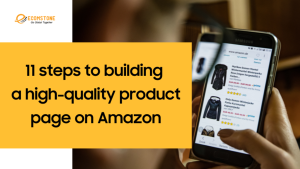Third-party sellers have been the lifeblood of Amazon since the birth of time. It’s easy to overlook that this platform is primarily an online marketplace, not a manufacturer or brand owner. It boasts 2.3 million active sellers and is still growing. Most of Amazon’s success stories use a sales model called wholesale.
Wholesale is the process of purchasing branded products from a manufacturer, distributor, or supplier in large quantities. The intention is to resell these products to Amazon consumers. Some good examples include popular consumer electronics, popular toys, and even kitchenware.
Selling wholesale on Amazon can be very profitable. However, don’t just jump in without testing the waters first. Research by consulting a company that offers Amazon seller services to know what you need to do to make your Amazon business venture successful. First, let’s first find out what wholesale is all about and discuss how to do it on Amazon efficiently.
Wholesale: The Basics
The process of selling wholesale on Amazon is all about following a few basic steps. It’s not simple, nor will it take just a few minutes. You need to put time and effort into this to ensure your success as a seller. Here they are:
- Create a seller account.
- Locate a product with reasonably high demand.
- Take care of the sourcing details (manufacturer, distributor, etc.).
- Craft an optimized listing to compete against other sellers.
- Launch and promote your new product.
- Grow and manage your business (this includes inventory, sales, etc.).
Not so fast! You might need to get a wholesale license, business license, or tax-exempt form to start selling using this business model. Do some research on what needs to be done. If you need to consult Amazon seller services or legal services, by all means, do so.
How Is Wholesale Different from Other Business Models?
Amazon sellers have a whole slew of other business models they use. In the beginning, they might all sound the same, but they’re not. Once you get the hang of it, the differences are hard to miss.
Resellers are people who buy products from a retail business for a discounted price and sell them on Amazon for profit. Sometimes, resellers purchase these products at regular prices and sell them at a slightly high price.
Reselling is different from wholesale in the number of products they buy and how they procure their inventory. Wholesalers make bulk purchases and resellers make individual purchases. Wholesalers negotiate directly with manufacturers, while resellers buy from retailers to sell retail on Amazon.
Private Label sellers are also different from wholesale, as they create their own branded products. Wholesalers purchase existing branded products in bulk.
Dropshippers are also a little different, as they don’t keep products in stock. Instead, they list products for sale on Amazon and place an order through their supplier. The supplier or manufacturer then fulfills the order on behalf of the dropshipper. Wholesalers own their inventory and can fulfill orders directly.
What Are the Pros and Cons of Selling Wholesale?
As with everything in life, there are advantages and disadvantages. The best we can hope for if you have wholesale products to sell on Amazon is the pros outweighing the cons.
Pros
- Higher Demand: Imagine how hard it is to start selling unknown brands on Amazon—with selling wholesale, you can forgo all of that by selling branded products that customers are already looking for (e.g., Apple, Kitchenaid, Samsung, etc.).
- Quick to Start: Besides reselling, wholesale probably has the most basic steps to follow, though being successful in it is a whole new conversation. Many businesses claimed to have gotten their business up and running within six weeks, with expert help, of course.
- Extremely Profitable: A large percentage of companies also said it took them less than three months to turn a profit, a significant advantage over private label sellers who claim to need at least six months to accomplish the same.
- Easy-to-scale: Though finding the right product and brand to sell needs extensive research, everything will be a lot simpler once you’ve found it. You can focus all your time on growing your business rather than putting a lot of effort into building a brand and crafting an effective listing.
Cons
- Competition: With millions of other sellers out there, it’s unrealistic to assume that you can find a brand with no significant competition. Established brands are usually offered by multiple sellers on Amazon. The fierce competition will sometimes feel like a bidding war. It’s about who can offer the lowest price.
- Initial Costs: Buying in bulk has the same drawbacks as reselling—you have to shell out some cash to purchase your inventory. The only difference is, buying in bulk requires you to invest a lot in the beginning.
- Research: This is perhaps the most time-consuming task in wholesaling. You might have to go through dozens or even hundreds of products before you find that elusive brand that will keep those Benjamins rolling. Firming up your supply chain is also included in the research. You have to know if your supplier can provide enough products on schedule.
Which Fulfillment Method Is Best?
Is this important? Sure, it is! This aspect of your business includes many vital processes, such as shipping, inventory storage, customer service, etc. You’re supposed to pick an effective fulfillment method that takes care of all those vital processes and leaves you to worry about other aspects of your wholesale business. Let’s look at your options.
Fulfillment-by-Amazon (FBA)
For people who’re just starting their business, this is the perfect fulfillment method to choose. The numbers speak for themselves. Brands that are readily available to Amazon Prime members are mostly the ones who use FBA. These Prime members spend roughly $1300 annually on Amazon purchases.
Amazon FBA takes some of the most important but time-consuming tasks out of your hands for a small fee. There are a bunch of advantages this method can give you.
- Amazon handles packing and shipping: Late deliveries are the most notorious culprits for causing bad reviews. If you don’t have a good shipping partner, using Amazon’s extensive shipping network should really be the only choice you have.
- Managing returns and customer service are out of your hands: Paying fulfillment fees to Amazon will seem insignificant compared to the stellar customer service that your buyers will receive. On top of that, refunds and returns will also be handled by their amazing team. What’s not to like?
- You wouldn’t need to think about inventory storage: Storage is also a big headache for many businesses—maintaining the temperature, keeping it clean, organizing your inventory, etc. Using Amazon’s spacious warehouses frees you from all those worries for a small storage fee. Believe me; it’s worth it.
- Amazon will reimburse you if any product gets damaged in their warehouse: Products getting damaged is nothing new when storing in bulk. Amazon FBA gives you the advantage of getting reimbursed if your products get damaged in Amazon’s fulfillment centers.
- FBA merchants almost always win the buy box: The buy box is a vital part of a product listing that almost always spells success or disaster for a seller. According to Amazon’s figures, 85% of sales happen through the buy box. If you choose FBA as your fulfillment method, there’s a big chance that you’ll win it, as long as you satisfy all the requirements for being eligible for it.
Many sellers claim that Amazon’s fulfillment and storage fees are a lot less than the actual costs if you fulfilled orders and stored the products yourself. Amazon FBA really is a load off your mind.
If you’re selling products that sell slowly, paying those fulfillment and storage fees might not be worth it. It’s the same with bulky and oversized items. Amazon will need to charge you a large fulfillment fee if standard shipping isn’t enough for your product.
As a business owner, knowing what fees you need to pay is essential. Using Amazon’s extensive fulfillment network doesn’t come free. There are additional fees that you may need to pay, depending on what happens to your business.
- Labeling fee: Amazon has strict rules for labeling products sent to them via FBA. You can choose to label your products by yourself or opt for an Amazon labeling service. This comes with a $0.30 charge for each item received and labeled by Amazon.
- Packaging fee: Of course, Amazon also has strict rules on the packaging. It’s got something to do with customer satisfaction. You can choose to package your products, or you can let Amazon pack them for a small charge. You will be charged an unplanned FBA prep fee for improperly packaged items because Amazon will repackage them according to the specifications it enforces.
- Returns processing fee: You will be charged a returns processing fee in categories that Amazon offers free returns. You will shoulder the cost of the free return, not Amazon. If repackaging is needed, you’ll be charged for that too.
- Long-term storage fee: When your products remain unsold for more than six months, you may be charged by Amazon for their storage.
- Stock removal fee: Removing unsold inventory from Amazon’s warehouse requires a small fee, depending on shipping weight. Use the FBA calculator, so you’ll know what charges will be applied to you.
Fulfillment-by-Merchant (FBM)
Being an Amazon FBA seller doesn’t apply to all situations. There are instances when FBM is more advantageous than relying on Amazon’s fulfillment network. This method allows you to list your products on Amazon and do the tasks related to fulfilling customer orders, such as shipping, returns, refunds, customer service, and storing your inventory.
FBM is very useful in these situations:
- Your product has a low-profit margin – save on storage fees.
- You want more control of your business.
- Exclusive products – You don’t sell that many products a month.
- Your inventory isn’t that much – save on fulfillment fees.
- The Logistics partner you have can offer shipping rates cheaper than FBA shipping fees.
Fulfilling orders by yourself doesn’t come free. There are specific fees that would apply even when using FBM. Let’s discuss them briefly.
- Monthly subscription fee: If you’re a professional seller, you need to pay $39.99 per month. For individual sellers, there’s no monthly charge.
- Per item fee: Professional sellers don’t have to pay this amount. Individual sellers need to pay $0.99 per item sold.
- Referral fee: The usual charge is 15% of the total sales price for most categories. However, it can range from 6% to 45% in some cases.
- Shipping fee: This charge applies if you opt to shoulder shipping charges yourself. You can also make your buyers pay for shipping. Unlike FBA, you’d need to ship this using your logistics partner.
Be Prepared for Everything
Going into Amazon FBA wholesale involves a lot of moving parts. To succeed in this business venture, you have to be prepared for everything. For many sellers, getting advice from companies that offer Amazon seller services gives them a lot of time to focus on growing their companies and leaving the grunt work to the experts.
For more information on Amazon FBA wholesale, you can contact us at hello@sellerinteractive.com or jayce@sellerinteractive.com.





